Before you can talk about the country’s best deer hunting states, you need to narrow the terms a little. There are three species (and nearly 50 subspecies) of deer in this country, after all. So, for starters, we are going to narrow this to the best whitetail hunting states. (Don’t worry, we’ll cover big muleys in a separate article.)
Then there’s the question of what constitutes “best”—numbers of deer, public access, cheap tags? Well, we figured if you’re going travel to hunt whitetails, why not dream big. Antlers aren’t everything, and, of course, you can have an absolute blast deer hunting without ever incurring a taxidermy bill. But for many whitetail geeks tagging, or at least having a legitimate shot at a mature buck is a big part of the thrill. So, we analyzed the Pope & Young (P&Y) and Boone & Crockett (B&C) record books, as well as information from the National Deer Association (NDA) and state agencies to assemble this list (in no particular order) of the best whitetail hunting states for taking a wall-hanger. So have a look and start dreaming—and maybe planning.
Table of Contents
Mississippi
Ohio
Kentucky
Oklahoma
Indiana
Missouri
Wisconsin
Illinois
Pennsylvania
Iowa
Texas
Kansas
The 12 Best Deer Hunting States for Big Whitetails
1) Mississippi
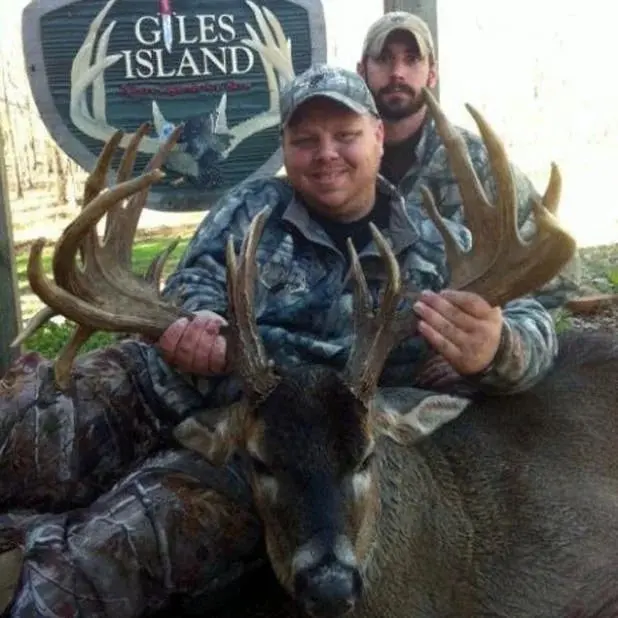
Mississippi is home to some giants. Joshua Bruce
Estimated deer population: 1.75 million
Number of deer hunters: 288,000
Public land: 2 million acres, between state WMAs and federal areas.
B&C: Typical: 48, nontypical: 47
P&Y: Typical: 654, nontypical: 22
Mississippi as a deer-hunting state is not only well-established but on the rise. It has been ranked as one of the top states for tagging a buck 3½ years old or older for several years by the National Deer Association (NDA) (79 percent of bucks were in the harvest in 2020). And success on antlerless deer borders on the ridiculous, with 81 does killed per 100 hunters afield. While Mississippi isn’t a heavy hitter in the B&C or P&Y record books, what is notable is that most of the top entries are recent bucks. The state’s top P&Y nontypical (236-⅛ inches, Tracy Laird) was killed in 2003 and the top typical (181-2/8 inches, Earl Stubblefield) in 2016. Virtually all the top-ten bow-killed bucks in each category have come within the last decade. And if you ever doubt Mississippi’s potential, consider Tony Fulton’s 295-6/8-inch giant, which has remained as the state nontypical record and #9 B&C nontypical since 1995.
2) Ohio
Estimated deer population: 680,000
Number of hunters: 388,000 (purchased permits)
Public land: 651,000 acres
P&Y: Typical: 4,247, nontypical: 404
B&C: Typical: 724, nontypical: 488
Not only is the Buckeye State included in any discussion of top whitetail states, but making a strong case for Ohio being the best is not hard. In addition to having a strong deer herd, long and cherished hunting tradition, and solid access to good whitetail ground, hunter success is high, with 59 does killed per 100 hunters (the best in the Midwest, according to the NDA). Plus, Buckeye State buck hunters have been shaking up the record books for decades. Need proof? Both the state record bow-kill typical (Tim Reed, 198-⅜ inches) and nontypical (Mike Beatty, 294 inches) whitetails are ranked #3 in the P&Y book. Ohio has led all states for nontypical B&C entries in recent years, and their top-end bucks are incredible; even if you throw out the 328-2/8-inch Hole-in-the-Horn buck (found, 1940), second place goes to Jonathan Schmucker’s 295-⅜-incher, and it takes a 255-inch buck to crack the state’s Top Ten. Looking for a big typical? Brad Jerman’s 201-⅛-i nch buck (2004) is ranked #13 in B&C, it takes a 188-inch typical to sneak into the state’s top ten—and every one of those bucks has been recorded since Jerman killed his giant.
3) Kentucky
Estimated deer population: 900,000-plus
Number of hunters: 300,000
Public land: 521,228 acres
P&Y: Typical: 1,507, nontypical: 166
B&C: Typical: 795, nontypical: 380
Another state with a strong deer-hunting tradition, Kentucky has produced top-end bucks in recent history. At least part of the Bluegrass State’s contribution to the record books comes from its one-buck limit; while the state’s whitetailers can kill up to four deer per year, only one can be a legal buck. Due to its early-September opener, Kentucky is arguably the best place to kill a whopper velvet buck and the P&Y books (which include a special velvet category) list 19 nontypical and 165 typical entries from the state in this category, including a 248-⅛-inch monster (Weston Cartwright, 2012) and 181-⅜-inch typical (Martin McGinnis, 2021). But Kentucky is no slouch in producing B&C entries, with two nontypicals over 270 inches and the state typical record, #7 all-time (Robert Smith, 2000) topping the 200-inch mark with 4 inches to spare.
4) Oklahoma
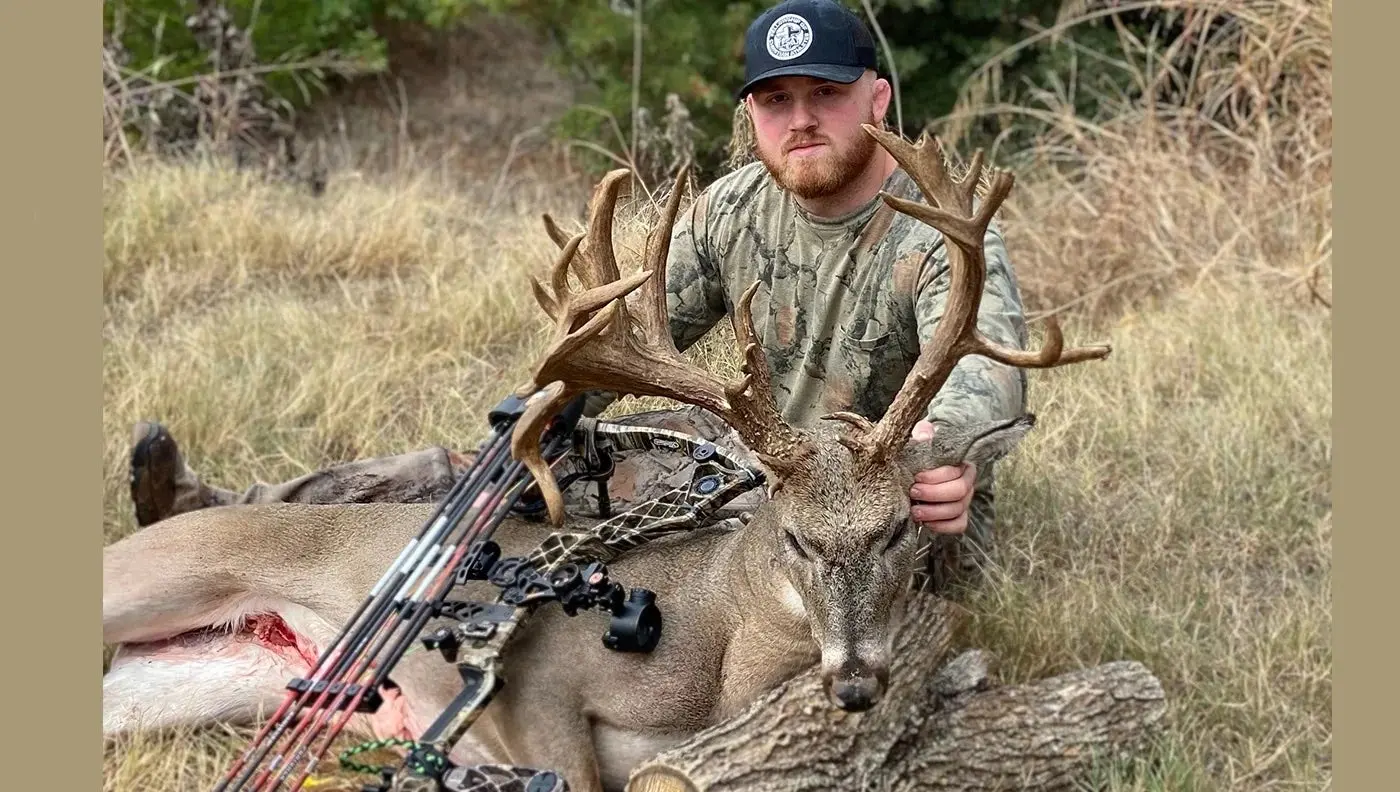
Oklahoma has flown under the radar for a while, but it’s home to some huge bucks. Connor Webb
Estimated deer population: 750,000
Number of hunters: 460,000
Public land: 1.7 million acres
P&Y: Typical: 770, nontypical: 104
B&C: Typical:112, nontypical: 151
Bordered by more famous neighbors Texas and Kansas, Oklahoma flew under everyone’s radar for many years—until it became impossible to ignore. With over 100 P&Y nontypicals–the top ten of which were all killed since 2000–and a state-record buck as good as they come (Travis Ocker’s 245-2/8-inch whopper, tagged in 2016), the Sooner State is a bowhunter’s dream. Overall management is excellent, as the NDA reports 83 percent of harvested bucks are 3½ years old or older—a stat that leads the nation in that category. Even more exciting is the amount of public land opportunities, which include state WMA’s (some managed for quality deer), national forests, and Army Corps of Engineers’ ground.
5) Indiana
Estimated deer population: 680,000
Hunter numbers: 220,000
Public land: 502,000 acres
P&Y: Typical: 3,407 nontypical: 284
B&C: Typical: 604, nontypical: 345
Some whitetail geeks weren’t paying much attention to the Hoosier State. But Dustin Huff corrected that in a big way last November when he shot the #2 B&C typical of all time in the state’s southeast corner. The 211-4/8-inch giant is the highest netting typical ever killed in the U.S., and the buck shined a spotlight on Indiana’s solid–and growing–presence in the record books. Over 3,000 typicals have flooded the P&Y books from Indiana, and it takes a 190-inch buck to crack the Top Ten B&C typicals. Like a trashy rack? Rex Millspaugh’s 259-2/8-inch (2020) heads the state’s P&Y entries, and Timothy Beck’s 303-⅞-inch (2012) is 8th on B&C’s all-time list. With a respectable amount of public land, a one-buck limit, and 41 percent of harvested bucks at least 3½ years old (best in the entire Midwest), expect Indiana’s trophy run to continue for a good long time.
Read Next: The Biggest B&C Nontypical Record Bucks From Every State
6) Missouri
Estimated deer population: 1.4 million
Hunter numbers: 500,000
Public land: Two million acres
P&Y: Typical: 2,440, nontypical: 251
B&C: Typical: 563, nontypical: 403
The Show-Me State is one of those stalwart Midwestern states that’s just tough to ignore. While hunter numbers are high and the amount of public land relatively small, Missouri remains one of the best-managed whitetail herds around, with 33 does killed per 100 hunters and 33 percent of bucks tagged at 3½ years old or older. And of course, it’s home to the Missouri Monarch, the “found” giant that remains the B&C world record nontypical. Hunter-killed trophies are almost as impressive; Randy Simonitich’s 269-⅞-inch bow kill (2000) is the #7 P&Y nontypical and Larry Gibson’s incredible 205-inch typical (1971) sits in the Top Five of B&C typicals.
7) Wisconsin
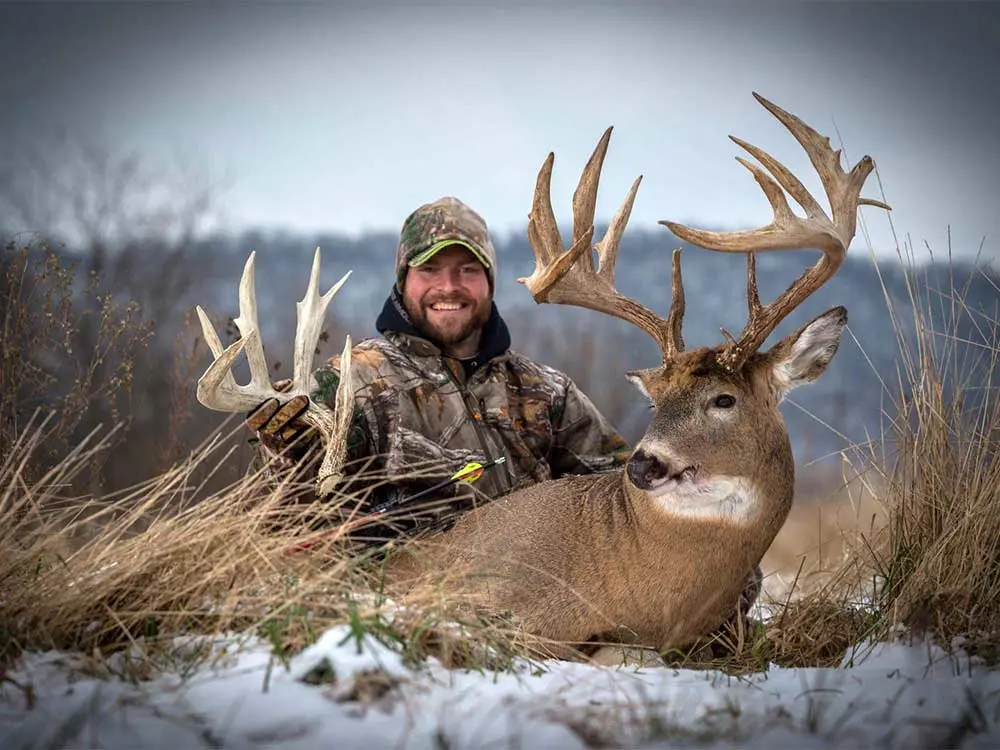
Joshua Gawrysiak’s massive Wisconsin buck grossed 216 6/8 inches. Joshua Gawrysiak
Estimated deer herd: 1.5 million
Hunter numbers: 630,000
Public land: 5.5 million acres
P&Y: Typical: 13,187, nontypical: 805
B&C: Typical: 1,399, nontypical: 561
The Badger State is a bit of an anomaly. Despite a yearling buck harvest as high as any Midwestern State (40 percent in 2020), a ho-hum antlerless kill (29 does per 100 hunters), and one of the longest and toughest fights with CWD as any state, Wisconsin continues to cough up incredible numbers of mature bucks. The state has dominated the P&Y book as the go-to spot for a book whitetail for decades, and the top-end bucks (191-6/8-inch Typical, Adam Hupf, 2014; 249-6/8-inch nontypical, Jim Baker, 2013) are not only impressive they were taken recently. Buffalo County retains its lead as B&C’s top county in the nation, but Wisconsin’s monsters are coming from all over the state, proof that hunters are managing for older deer.
8) Illinois
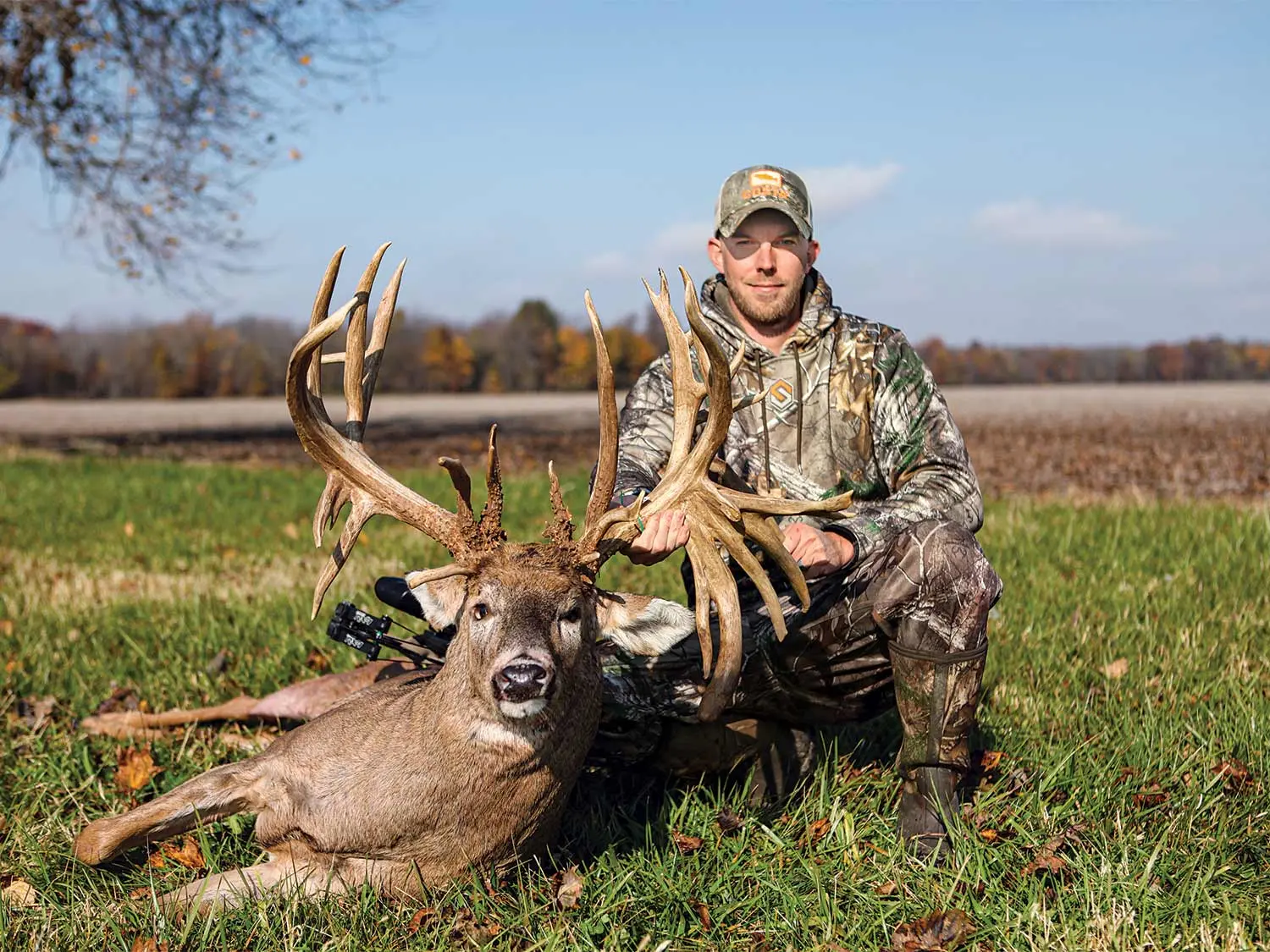
Luke Brewster and his world record whitetail. Luke Brewster
Estimated deer herd: 640,000
Hunter numbers: 255,000
Public land: 698,000 acres
P&Y: Typical: 7,621, nontypical: 905
B&C: Typical: 854, nontypical: 709
Not long ago, many whitetail nuts (some of the state’s hunters included) were murmuring that Illinois’ best days were in the rearview. Then in 2018, Luke Brewster had something to say to the doubters when he tagged the biggest hunter-killed nontypical—a 327-⅞-inch colossus—in the B&C books. While one buck might be a lightning strike, the Prairie State’s record book is as packed with recent giants as it is historic kills; of the Top Ten Illinois nontypicals in the P&Y books, only two were killed pre-2000, and only three were B&C nontypicals. The Illinois records resume is simply studded with world-class deer; it’s the only state with two hunter-killed bucks over 300 inches (Brewster’s buck joined Jerry Bryant’s crossbow-killed 304-⅜” titan) and two world records (Brewster and Mel Johnson’s P&Y typical, a world-leader since 1965). The state has done a largely competent job managing CWD, increasing deer numbers in below-goal units, and responding to other farm-country challenges. Anyone tempted to write Illinois off the nation’s top spots better think again.
9) Pennsylvania
Estimated deer herd: 1.5 million
Hunter numbers: 663,000
Public land: 3.7 million acres
P&Y: Typical: 1955, nontypical: 82
B&C: Typical: 92, nontypical: 43
No, the Keystone State is not on the list of heavy hitters in B&C, and its top-end bucks can’t compete with the best of the best. But no discussion of top deer states would be complete without mention of PA, which rivals places like Wisconsin, Michigan, and Texas. The state has staged a monster comeback in terms of management in recent years, with the adoption of Antler Point Restrictions and an increased emphasis on balancing the herd with the habitat. In the 2021 season, 62 percent of harvested bucks were 2-½ years old or older, and the record books reflect that sea change. The number of P&Y typical entries is very respectable, and eight of the top ten typicals (and seven top-ten nontypicals) have all been taken since 2000. With a tradition that can be traced to the roots of modern deer hunting, Pennsylvanians are living “the good old days” right now.
10) Iowa
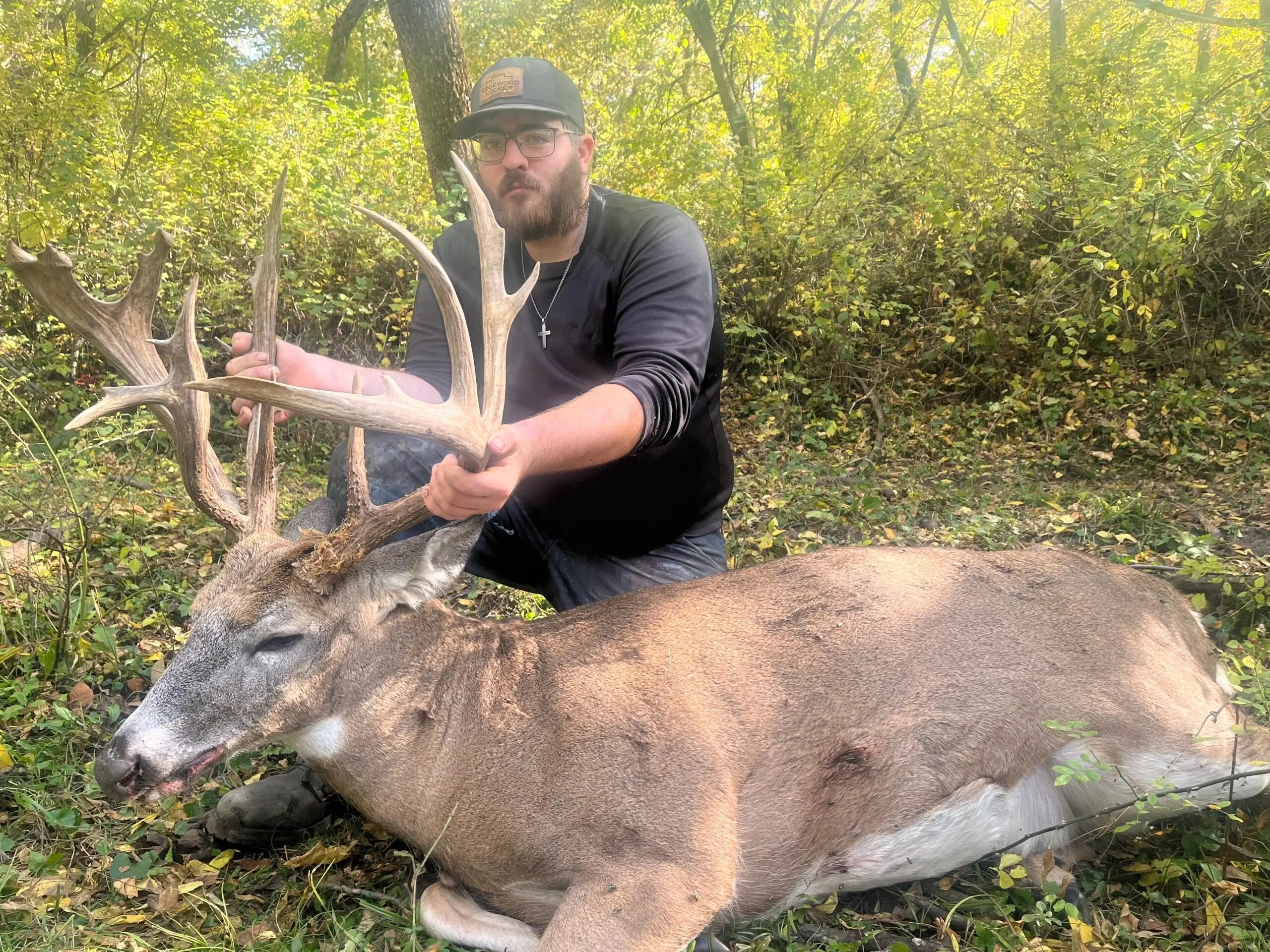
It’s hard to beat Iowa for big whitetail bucks. This 198-inch monster was taken by Laran Kaplan. Laran Kaplan
Estimated deer herd: 445,000
Hunter numbers: 340,000
Public land: 763,800 acres
P&Y: Typical: 4,986, nontypical: 695
B&C: Typical: 831, nontypical: 630
There are always a few no-brainer entries in a list like this, and the Hawkeye State is certainly one. You don’t have to watch outdoor television very long to find shows focused on Iowa and its giant whitetails, but what’s lesser known is the overall opportunity here to harvest a great buck. Thanks to ample food, relatively easy winters, and excellent management by the DNR, chances for a trophy buck are solid throughout the state. Iowans are serious about killing does, and more hunters are passing on younger bucks, the perfect formula for growing mature deer. Iowa’s P&Y entries are as impressive as anywhere, especially on nontypicals; Deric Sieck’s 2016 288-4/8-inch buck leads the group, and all top-ten nontypicals have been taken since 2000 (five within the last five years). Tony Lovstuen’s 2003 “Walking World Record” buck (307-⅝ inches) is ranked 6th on the B&C records and is the 4th largest hunter-killed nontypical.
11) Texas
Estimated deer herd: 5.3 million
Hunter numbers: 740,000
Public land: 1.5 million acres
P&Y: Typical: 2,059, nontypical: 131
B&C: Typical: 550, nontypical: 311
There are plenty of savvy and successful whitetail managers across the country, but virtually all the basics of the art and science of growing really big deer can be traced to Texas. Whitetail hunters there have been managing for mature bucks for decades, and the record books reflect that success. With the long and rich history of whitetail hunting in the Lone Star State, it’s no surprise that some historical bucks appear in their all-star list. But there are plenty of recent stars in there as well. The top P&Y bucks were a typical shot by Thomas Friedkin (187-6/8 inches) in 2005 and a nontypical killed by A. Downs (256-⅞ inches) in 2012. The B&C typical leader for the state was shot just last fall (Alberto Balleres, 197-2/8 inches), and the top hunter-killed nontypical (Robert Baker, 268-⅜ inches) fell in 2020. While most of the state’s top-end bucks come from highly-managed private ground, there are enough public areas that can cough up a solid, mature buck.
Read Next: The Biggest B&C Record Whitetail Deer from Every State
12) Kansas
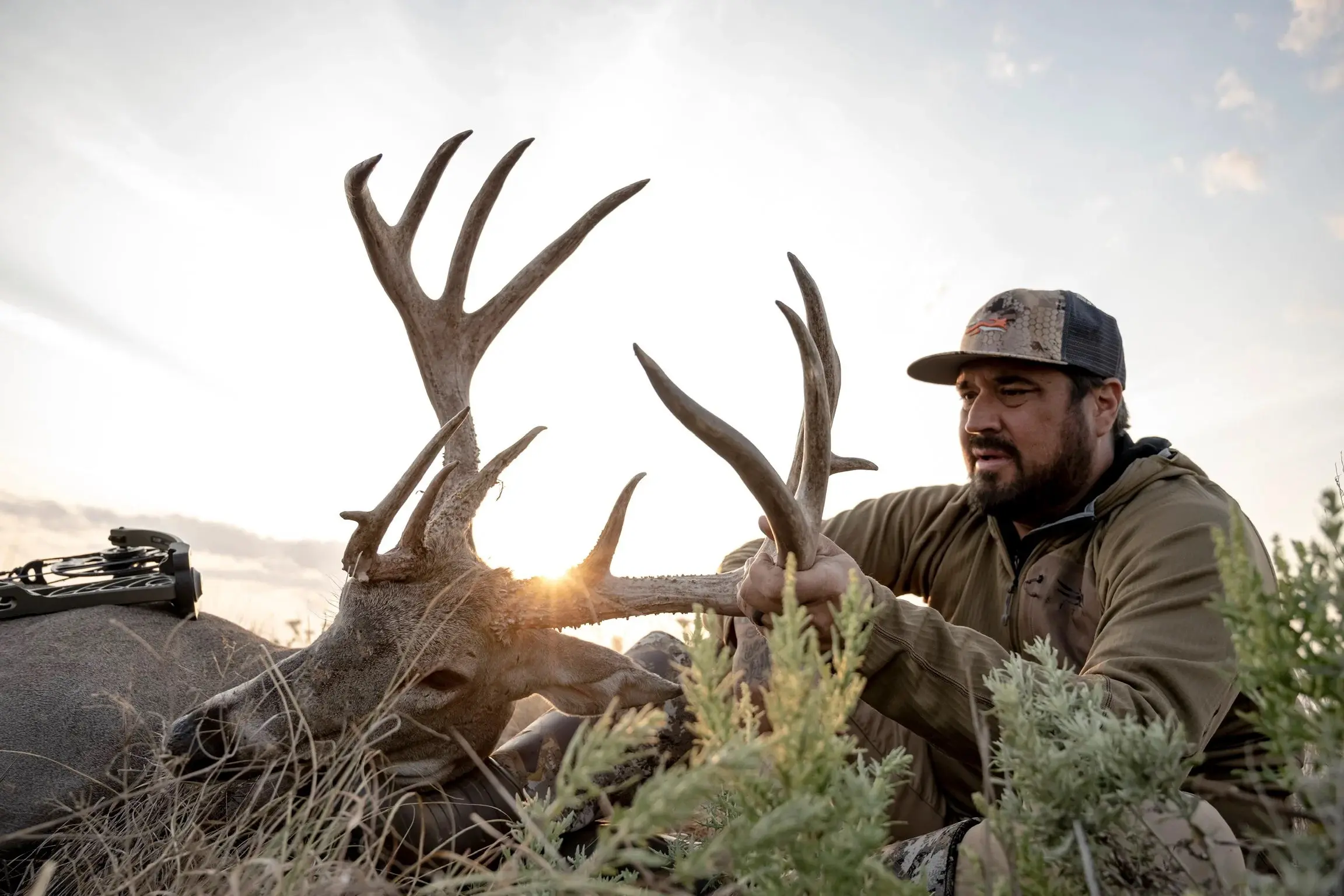
Pete Alfano took this Kansas beast in September of 2022. Pete Alfano
Estimated deer herd: 700,000
Hunter numbers: 108,000
Public land: 300,000 acres (plus Walk-In Hunting Areas)
P&Y: Typical: 3,279, nontypical: 547
B&C: Typical: 507, nontypical: 453
No list of the best deer hunting states for giant whitetails would be complete without Kansas. In addition to an impressive number of P&Y entries, Kansas also produced the #2 P&Y nontypical of all time: the Brian Butcher buck (321-⅜ inches, 2019) a buck that also sits at #4 in the B&C book. On the typical side, the Brad Henry buck (193-⅞ inches, 2001) leads the state P&Y lineup, which is packed with recent kills. If there’s a downside to the Sunflower State it’s the lack of public land, but savvy hunters will focus on unique opportunities, such as Walk In Hunting Areas (WIHA) and military installations. They’ll also recognize that, while many of the state’s top-end trophies come from the eastern (more timbered) counties, there are great bucks living throughout the state, often in habitat that seems more conducive to growing pheasants and quail.
Best Deer Hunting States by Population
What’s that, you don’t care about antler size? You just want to go someplace where you’ll see loads of deer and have fun chasing them. No problem. We get totally get that, so here is a list of the top five states with the most whitetail deer, according to the latest population estimates.
1. Texas
The Lone Star State is number one by far, with a whopping estimated herd of 5.3 million.
2. Mississipi
Mississippi is not only on a sharp upswing for big deer, but it also has an impressive estimated population of 1.75 million whitetails.
3. Alabama
And right next door to Mississippi is another 1.75 million whitetails, in the state of Alabama.
4. Pennsylvania
The Keystone state is next with an estimated 1.5 million whitetails.
5. Wisconsin
And Wisconsin rounds out the top five with the same number, 1.5 million.


